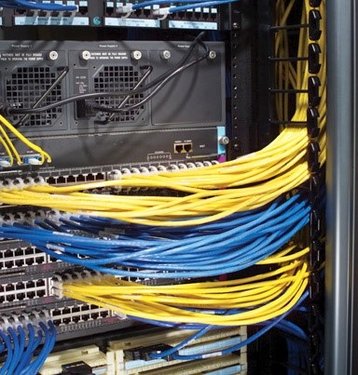Network cable densities are increasing every day. With floor space always at a premium, the average rack cable density and its management is becoming more critical. Technology refreshes also create havoc with combinations of adds and drops and mixed media throughout existing physical infrastructure. It is just not as simple as going from point A to point B to route all your cables within the network.
The purpose of the physical infrastructure, at its basic terms, is to support the network electronics and cabling in a safe and secure manner and provide a passage way that will maintain signal integrity. There are plenty of examples out there of cabling gone wrong, due to the lack of proper cabling systems from the inception of the network, whether in the data center or in building networks. Control of the personnel responsible for installation and maintenance of the infrastructure and the cabling is very important, but there are some simple methods and products available that will ensure the integrity of your network.
Best practices
Open rack systems have consistently been an excellent method to secure structured cabling. The key to maintaining the proper bend radius and avoid cable being pulled taught after installation is to have three points of containment of the cabling at the back area of their specific terminations. This will not only allow control of the bend radius, but it will keep any strain off the critical terminations, which could possibly cause a signal loss in the point to point connection.
Copper structured cabling can be easily controlled once in the rack using this three point control method, as the bend radius’ are maintained throughout, and it is even ideal for adding additional runs for tech refresh or simple additions.
Copper patch cord is also a key area of concern for network integrity. As electronics are installed in the racks, careful thought must be given as to how the signals are going to get from the equipment out to the building network or other electronics in the nearby network. Location of patch panels and horizontal managers in the specific rack will help to easily route the patch cord of any length throughout their locations in the system.
Vertical managers and their accessories are crucial parts of the cabling system schemes for both fibre and copper. The vertical managers of the system will bring fibre and copper cables safely in and out of a single rack or can help cables run from rack to rack within the network. Most vertical managers will have some type of door to protect cabling and keep it from getting loose, snagged, or tangled. This also maintains a clean look in the data room or data center.
Vertical managers will usually have some type of RU increment fingers which will help to separate copper and fibre cables destined for specific locations within the rack.
These fingers will captivate a section of cables heading to either side of a patch panel or an electronic assembly, and will help to create a safe passage for those cables. The RU fingers will also create a safe bend radius for cables coming off the front of switch cards or other electronics and the integrity of the cabling is guaranteed. The switch port is also completely protected from strain.
The fingers may be used in conjunction with bend limiting clips, which will eliminate kinks in cables, primarily fibre cables. The fibre is safely and securely delivered to its destination on the smooth transition of the clips. The clips will snap into specific fingers and can be relocated as the network grows and changes. More can also be added.
Overall, the needs of any specific networks may differ, but having the proper physical infrastructure to create a safe environment for the point to point terminations of both copper and fibre is very important. The items outlined within are just a few ways that cabling systems can provide an excellent backbone for all immediate and future requirements. The best networks start with structures that will allow cables to route in a multitude of ways, but will always protect against signal loss or any type of damage to equipment.
Domenic Trapassi is product manager for racks and cable management at Legrand’s Data Communications Division



